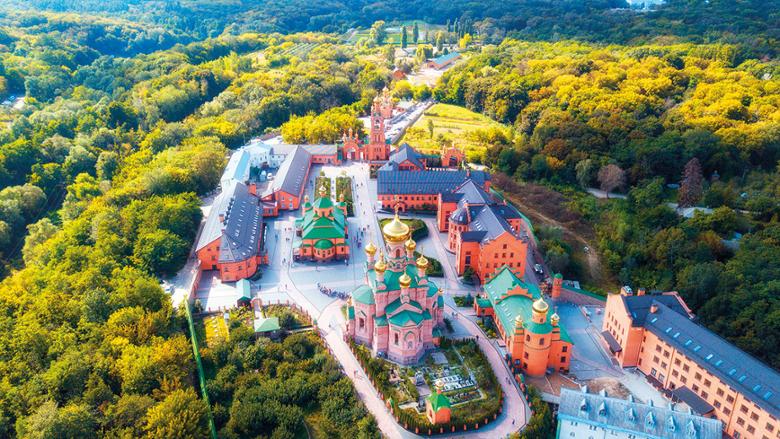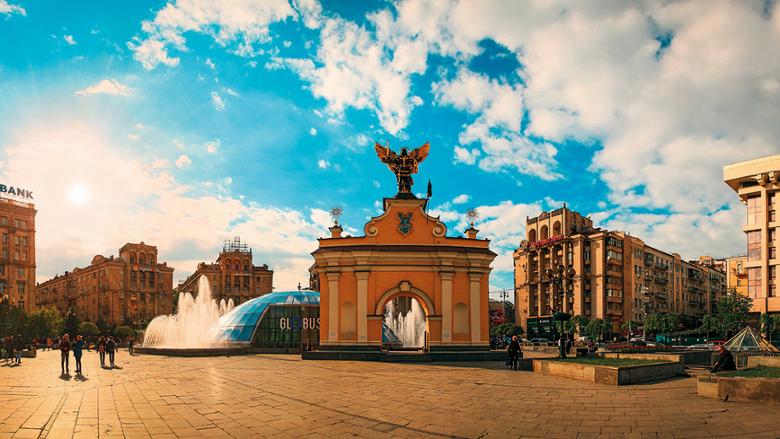In Ukraine, where the style is baroque with a dash of Lego
Fun, quirky and with a comedian newly elected as president, Ukraine is charting a unique path, says John Gimlette
You shouldn’t be too surprised that Ukraine has elected a comedian as its president. Every day in Lviv there’s a little revolution, and it’s mostly fun. Each night its people go to bed a little less Soviet, and the city gets younger and younger. Colour is returning to the hotels, and the shops are now full of exotica, such as drones and iPods and fancy innerwear. Even the city’s police look like teenagers in their European cars and spiffy new outfits. ‘We got rid of the old fatties,’ said our guide, Tymor, ‘in the 2014 uprising. Too corrupt, too pro-Russian.’
Counter-culture rules, or at least inspires. Take the restaurants. One of the latest, Ukrainian Food Art, has a see-through piano that plays itself, and a shark tank that rises up through several floors. Another, called The Masonic, has a secret entrance that leads through a grungy bedsit into a magnificent brasserie with a car suspended from its ceiling.
But perhaps the quirkiest place was Livy Bereh (Left Bank), which was once an underground river. With its whitewashed antiques, it’s now the haunt of The Beautiful People. Drinks are served in fire extinguishers, and the barman wears a white leather mask. ‘Ukrainians have become a bit anarchic,’ said Tymor, ‘we’re rewriting the rules.’
Ukraine’s metamorphosis isn’t always so obvious. Our week-long family trip began with the overnight sleeper from Kiev. The ageing train was like the Soviet Union itself: ponderous, orderly and prim. We slept on starched white sheets, and an attendant in a quilted greatcoat brought us glasses of tea. Outside, the snowy black steppes flickered past, and then, at dawn, a film set appeared. It was the grand old station of Lemberg – or Lviv – circa 1900.
In this revolution, time sometimes goes backwards, and a beautiful city has reappeared. Admiring its cobbled streets and classical facades, I half-expected to see Habsburgs again. They’ve left so much of themselves behind: kiosks, palatial cafes, titanic statues, parks, and a twinkling opera house. Meanwhile, the chocolate is as good as ever – although, these days, it comes in all shapes and sizes, from a human appendage to an AK47.
In today’s Lviv, anything goes. I’d often see the same angel flying around the city on her roller skates. In the giddy Noughties, all the big brands arrived, along with onesies, Private Clubs, and Armani dog coats. But strangest of all was a network of watering holes deep beneath the cobbles, known as The Bunker. You need a password to get in ("Glory to Ukraine!") and all the staff are dressed as guerrillas. But it’s cheap and raucous, and there’s a Vladimir Putin punchbag.
Of course, not everyone is out enjoying beverages. Twice we made trips into the country. I loved the castles, particularly Olesko (with its giant canvas, The Battle of Vienna, 1682). We also met a jolly herder, with a pet eagle on his arm. But elsewhere, the villages could look uncomfortably medieval, a reminder that Ukrainians are the poorest people in Europe.
Our journey back to Kiev was full of surprises. The station felt like a film again, with soldiers heading back to the front (Ukraine is in the fifth year of its low-grade conflict, far off in the Donbass). But then our train arrived, now looking sleek and futuristic. On board, we ate quinoa salads, and even the steward’s outfit had the air of a starship about it. Five hours later, we were swooping into the capital.
Initially, Kiev was only as strange as I’d expected. The outer suburbs – pulverised in 1941 – now look like distant plateaus of concrete. In places, it seems only the monasteries survived, with their gigantic onions of gold. Our favourite was Kyevo-Pecherska Lavra, or the Monastery of the Caves, a sprawling complex of tunnels and mummies. In the 11th century, hermits often had themselves entombed here – alive – foregoing forever human company and the light of day.

What I’d not expected was the sheer audacity of Kiev. Everywhere there were bright designs and flashy cars. It’s hard to believe it was ever Soviet. Even Stalin’s great masterpiece, Khreschatyk Street, is discernibly hip. It’s the same with Tsum, the old state emporium. Once drab, it’s now a sort of Harrods, except bolder and brasher.
I’ve never known change so rapid and passionate. Kiev even has a new Latin quarter, Vozdvizhenka. With its grand eateries and funky turrets, it’s hard to know what you call this style. Baroque, perhaps, with a dash of Lego.
At the heart of this great cultural revolt is Maydan Nezalezhnosti (Independence Square). In 2014, half the city turned up to rail at a president seen as Putin’s puppet. Around the square you can still see pictures of their tented camp and the burning barricades. More than 100 people were killed, and 15,000 injured. A tiny museum has recently opened to commemorate their sacrifice (we were the first to sign its remembrance wall).
The overthrow of tyranny is a popular theme, even in restaurants. Some are fabulously chic (and yet we seldom paid more than Dh55 a head). My favourite was Ostannya Barykada, (The Last Barricade), a glorious underground lair of chrome, polished concrete and local produce (even the cheddar). Then there’s Veterano Pizza, run by ex-soldiers, and Spotykach, which gently mocks the Soviet era. Its food is inspired, if surreal. I had herring eclairs and borscht served cosmonaut-style in a squeezy tube.

Before leaving, we visited two more museums. The first was a complex of 16 halls beneath the Motherland Monument. Here, brilliantly displayed, is a terrible century. More than eight million Ukrainians died in the Second World War, leaving behind a gruelling residue of hardware, including guns, a guillotine and a mill for crushing bones. Equally poignant is the Chernobyl Museum. Thousands perished in the clean-up, and all that remains of them are snapshots and watches, and their pitiful medals.
[A simply way to make museums child friendly: treasure hunting!]
Our last night, we ate at Zhizn Zamechatelnykh Lyudey (Lives of the Great). Dominated by a gorgeous wall of books, it was indefinably cool. The locals were in party mood, but were puzzled by Brexit. Why was the UK leaving? For them, the EU’s banner is a rallying point, a rebel flag.
But we did promise to return. Who knows what the next few years under the new president will bring. Less poverty and ever more ingenuity? Meanwhile, I have my souvenirs, a curiously quirky haul: some Carpathian honey and a little tank made of bullets among others.